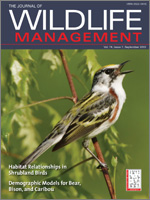Loss of quality brood rearing habitat, resulting in reduced chick growth and poor recruitment, is one mechanism associated with decline of greater sage-grouse (Centrocercus urophasianus) populations. Low chick survival rates are typically attributed to poor-quality brood rearing habitat. Models that delineate suitability of sage-grouse nesting or brood rearing habitat at the landscape scale can provide key insights into the relationship between sage-grouse and the environment, allowing managers to identify and prioritize habitats for protection or restoration. We used Southwest Regional Gap landcover types to identify early and late greater sage-grouse brood rearing in east-central Nevada. We conducted an Ecological Niche Factor Analysis to 1) examine the effect these landcover types and other ecogeographical variables have on sage-grouse selection of brood rearing habitat, and 2) generate landscape-scale suitability maps. We also evaluated if incorporating a fitness component (brood survival) in landscape spatial analyses of habitat quality influenced our assessment of habitat suitability. Because 36% of our 6,500-km2 study area was identified as early brood rearing habitat, we believe this habitat may not be limiting greater sage-grouse populations in east-central Nevada, USA, at least in wet years. We found strong selection for particular landcover types (e.g., higher elevation, moist sites with riparian shrubs or montane sagebrush) during late brood rearing. Late brood rearing habitat on which broods were successfully reared represented only 2.8% of the study area and had a restricted distribution, suggesting the potential that such habitat could limit sage-grouse populations in east-central Nevada.
How to translate text using browser tools
1 September 2010
Landscape-Level Assessment of Brood Rearing Habitat for Greater Sage-Grouse in Nevada
Michael T. Atamian,
James S. Sedinger,
Jill S. Heaton,
Erik J. Blomberg
ACCESS THE FULL ARTICLE
It is not available for individual sale.
This article is only available to subscribers.
It is not available for individual sale.
It is not available for individual sale.
brood rearing habitat
Centrocercus urophasianus
Ecological Niche Factor Analysis
greater sage-grouse
habitat suitability
landscape management
Nevada





